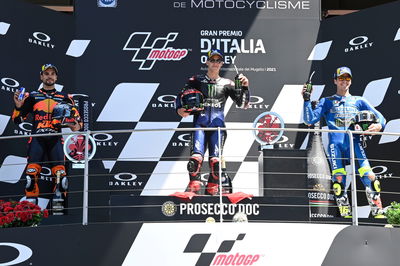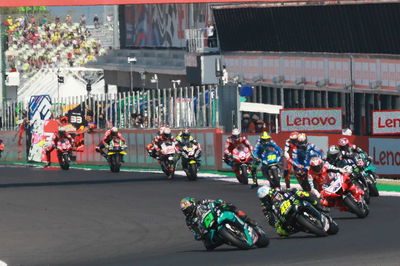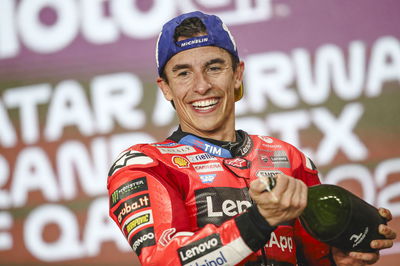'Striking distance' - Track limit rules in last lap MotoGP battles

MotoGP's track limit rules have been the subject of much discussion this season, not least after the final lap of the Italian Grand Prix at Mugello.
Johann Zarco remained classified in fourth place, despite the riders just ahead of him - Miguel Oliveira and Joan Mir - both exceeding track limits.
While multiple track-limit violations are normally punished by a long-lap penalty during most of a race, because there is no time for such a punishment to apply on the final lap, riders are instead docked a position if they exceed track limits while in a close battle with another rider and are judged not to have lost any time when running wide.
Oliveira finished the Mugello race in second place, 0.408s ahead of Mir, with Zarco then 0.535s behind the Suzuki rider.
A track limits penalty soon flashed up for Oliveira, dropping the KTM rider to third and moving Mir to second. But a few minutes later, Mir also received the same penalty, for the same infringement at the same Turn 5, while just a few metres behind Oliveira.
As a result, Mir returned to third and Oliveira to second. In other words, their finishing positions were unchanged.
Had the pair been in isolation, several seconds clear of Zarco, that would have been the end of the matter. But the question raised was why the two riders just ahead of Zarco had both exceeded track limits, yet the Frenchman still remained in fourth and didn't benefit by a single place?
Did it mean, for example, that if first and second in a group of five riders both exceed track limits on the last lap, they cannot be punished since - after swapping places due to the first rider's penalty - the top two then return to the original finishing order after the second rider's penalty, leaving third, fourth and fifth unchanged?
Demoted one position for exceeding track limits! @_moliveira88 drops to 3rd place but it's still a first podium of the season! #ItalianGP pic.twitter.com/vsuMzAnJ86
— MotoGP (@MotoGP) May 30, 2021
Well, scrap that! @JoanMirOfficial also exceeded track limits and his @_moliveira88's initial positions have been reinstated! #ItalianGP pic.twitter.com/aGehO9nS3d
— MotoGP (@MotoGP) May 30, 2021
Race director Mike Webb explained that the key criteria for the FIM Stewards is whether a following rider is judged to be 'within striking distance' when a last-lap track limits offence is made.
"The penalties are based on the protocol for track limits, and in this case it is the designated special case of ’track limits on the last lap of the race’," Webb explained.
"The key part is that for riders closely contesting a position on the last lap, a rider who exceeds track limits must not only gain no advantage, they must show a clear disadvantage compared to a rider who stays on track with whom they are closely contesting the position.
"The [FIM] stewards use the concept of “within striking distance” to ascertain 'closely contesting’.
"Obviously the target of the regulation is to avoid a race result based on a passing move made (or fended off) illegally by being out of track limits.
"Therefore the change of position penalty only applies to riders who were close enough to have a reasonable chance of making a pass, and half-a-second or more back would normally not be considered a reasonable attacking position.
"There is not a hard-and-fast time difference applied as circumstances are different depending on the track and corner. As with most steward’s decisions it’s a judgement call.
"The same protocol is always applied (eg. Red Bull Ring last turn) and explains why a rider following some distance behind does not automatically move up a place in case of an infringement.
"It applies only to the riders closely and directly contesting the position, with a reasonable chance of a pass being made."
'The interpretation for me was correct'
While making clear he wasn't protesting the Mugello race result, Zarco's Pramac team manager Francesco Guidotti had visited Race Direction after the grand prix to understand more clearly how the last-lap track limits punishments are applied.
"I went upstairs just to let me clarify how the interpretation is made in this case, which for me was correct. I didn't go there to make any protest, just to know what was the interpretation," he said.
"They told me that both riders, Oliveira and Mir, went on the green at Turn 5. In that sector, Zarco was 0.7 behind, so in that case he was far enough [behind] not to apply the [position change] penalty.
"If it was less than half-a-second, it would be a different interpretation. But 0.7s behind - I mean, when they went out of the track by 5-10cm, to be honest for me it's okay."
As well as supporting the decision, Guidotti added that it was important to have enough flexibility within the rules to make a judgement call on each situation.
"I went there just to know [how they base their decisions] because the rules are very general, but I prefer it that way because if you make that kind of rule too strict and the range is too narrow, we risk a disaster.
"Because on the last lap, it depends how many [riders are in the group], the layout of the circuit, if it's easier to go out or not, and the rideability of the bikes. So it should be different for MotoGP, Moto2 and Moto3.
"We need that someone makes an interpretation of every single case. Like in this case I think they had the right vision of what happened."
'Once in the green, then the second time a penalty'
Meanwhile, Aleix Espargaro is among those calling for less tolerance of track limits violations made before the last lap of a race.
The Aprilia rider feels that instead of allowing multiple mistakes before issuing a long-lap penalty, competitors should only be allowed to touch the prohibited green area outside of the kerbing once without a punishment.
"My opinion is that, if I decided the rule, once in the green, then the second time, a long lap penalty," Espargaro said. "Why should you have four chances to touch the green? In the past this area was very slippery, it was not asphalt, so if you touched it you lost 3 or 4 seconds. Or sometimes, as here in Assen, when it was raining the night before, you can crash.
"So why are we allowing them to touch [the green] four times? I don't understand this rule. So we are pushing a lot in the last few months to remove it. I hope that, OK, one chance, in terms of safety. But on the second one, a long lap penalty. If I have to decide, and I hope it's going to be like this."












